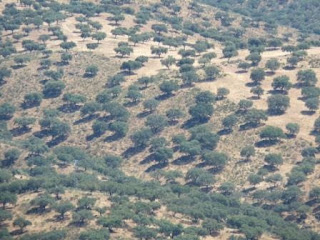Sun and shade
We are in the middle of the first heatwave of the summer. As I write it is 4pm and in the shade of our porch it is 36 degrees Celsius. The hottest time of the day is between 6 and 7 pm, so I expect it will hit 38 and then remain above 30 degrees until nightfall and the forecast is for another week of this weather, at least. Thanks to our relative altitude here (about 630 metres above sea level) and north-facing aspect, we are a comfortable two or three degrees "cooler" here than nearby Trujillo. Even so, the best place to be at this time of day is indoors, where the old thick mud-and-stone-built walls of our house create the perfect conditions for escaping the heat to read, write, rest or take a siesta. The day is long enough for one to feel that outdoor activities, for a few hours at least, can be put to one side.
I love the pace of summer in Spain, a sensible slowness takes over every living thing. Here in rural Extremadura, outdoor work is now pushed to the first few hours of the day or into the evening, with everything shutting down in the heat of the afternoon. It appears that nothing is out in the sun. Even the trees seem asleep. Birds are resting and going to extraordinary lengths to find shade - look on the shady side of a telegraph post and perched on the wire, as close as possible to the post will be a Magpie, Lesser Kestrel or Iberian Grey Shrike. Even the butterflies withdraw from the full blast of the sun at this time of the afternoon. The photo above shows the dehesa landscape in summer, where each tree gives shade and therefore refuge and each canopy contrasts dark green against the yellow-gold of the parched ground - an intricate patchwork of sun and shade.
But there is plenty to do. The garden needs lots of attention, especially the vegetables. I have a 300 litre water tank in the vegetable garden, from which I have set up a drip-irrigation system to keep the tomatoes, peppers, aubergines, and cabbages watered. This gets filled everyday from one of our boreholes, a task which Patrick helps me do each evening, with the water entering the tank, crystal clear and deep-ground cold, refreshing us as it gushes out of the pipe into the tank.
The mid-summer produce (see photo above) is looking good this year. Claudia and I find some shade in the evening to sit and watch the butterflies - like this Spotted Fritillary coming to the Buddleia, or the antics of the Nightingale bathing in the foot bath of the outside shower. A time to recharge batteries, reflect on the busy season that has just finished and starting drawing up plans for the rest of the year. But most of a recovery of quality time together.
It truly feels like the middle of summer, and yet the evidence for the turn of the year is building up. This morning I went out at dawn to the rice fields where the number of autumn passage waders is slowly increasing. Last month Green Sandpipers and Lapwing had arrived, now as well as three Black-tailed Godwit, there were two Wood Sandpipers and an interesting party of male Ruff, twelve in all, with blotches of colour on their plumage, remnants of their spring courtship garb. From their vestigial lekking behaviour, as they crouched and ran towards each other, turned and twisted, it was almost as if I was watching them on a wet meadow in Holland, instead of atop a sandy bank in Extremadura, alongside Collared Pratincoles and Black-winged Silts. Nearby four male Little Bustards, their nuptual challenges now forgotten, were feeding on an irrigated pasture. Over the next few weeks others will join them, the group growing in size and becoming a winter flock.






Comments